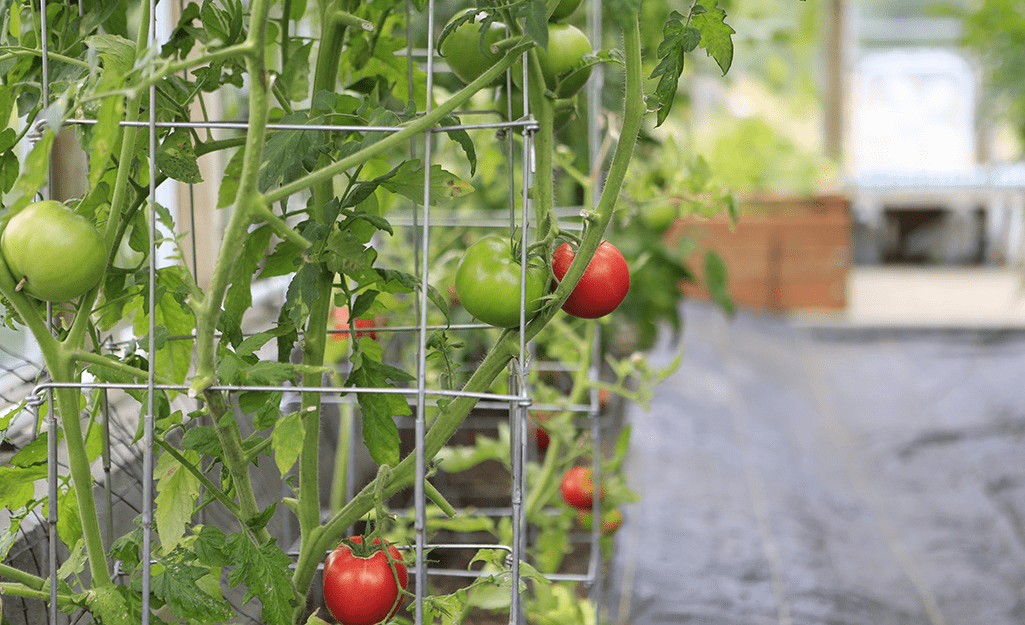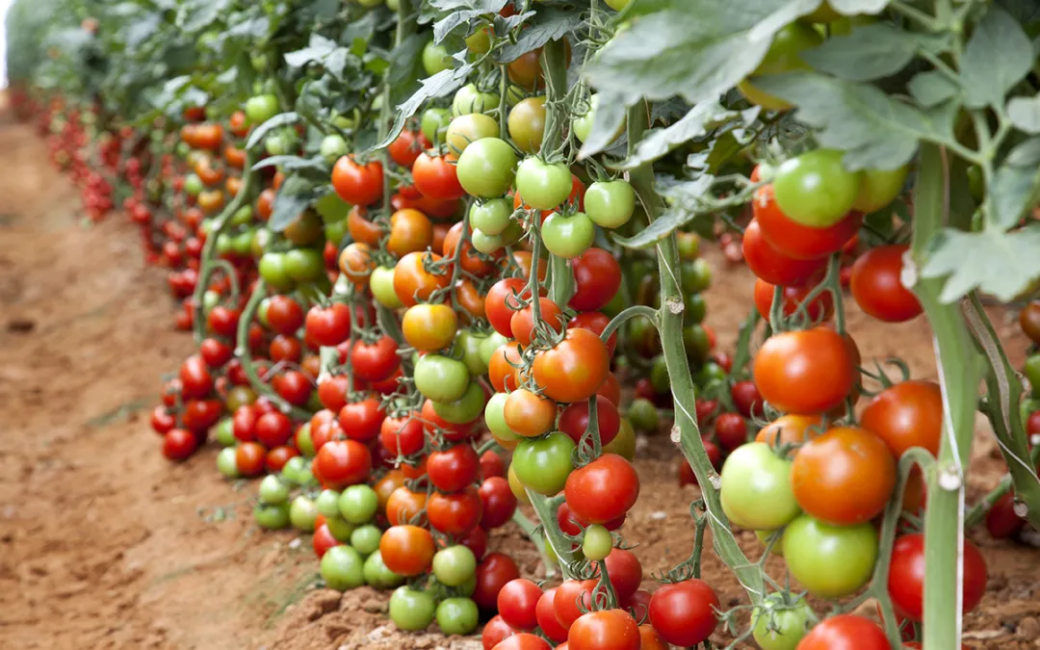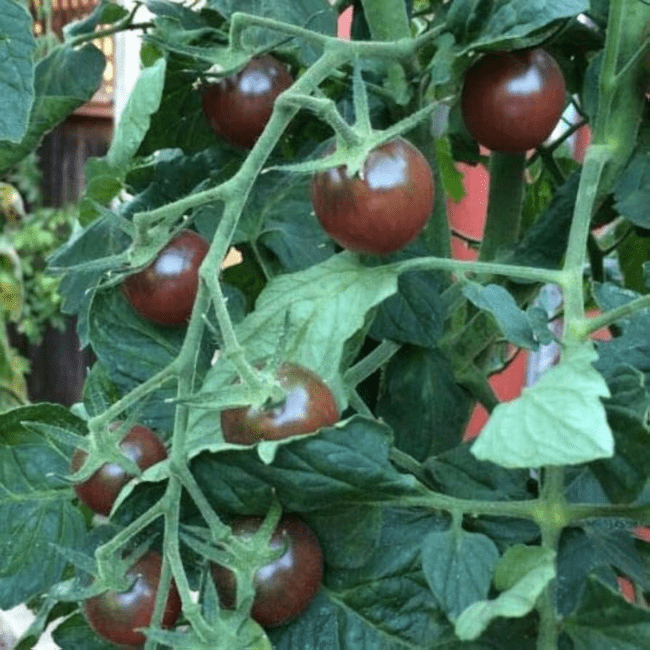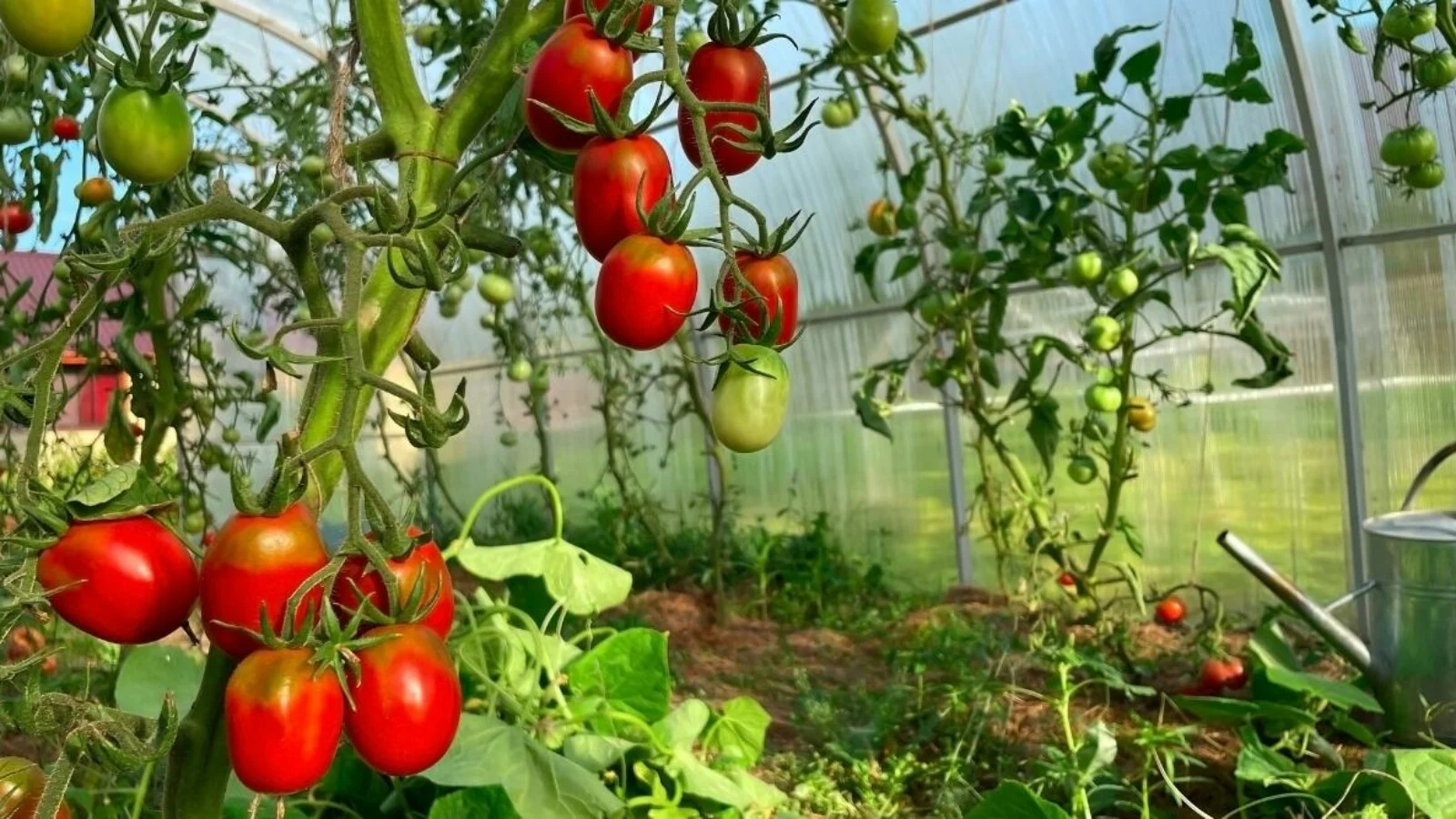Tomatoes (Solanum lycopersicum) are warm-season annuals that grow best when the soil temperature is at least 55°F (12°C) and the air temperature ranges between 65° and 90°F (18-32°C).
- Tomatoes are commonly grown from seedlings started indoors that are later transplanted into the garden.
- Tomato seeds are commonly planted indoors as early as 8 to 6 weeks before the average date of the last spring frost.
- Tomato seedlings are usually transplanted into the garden 1 to 3 weeks after the last frost. If an unexpected frost threatens, transplants must be covered and protected.
- Early-season tomatoes require 50 to 60 days to reach harvest from transplanting; mid-season tomatoes require 60 to 80 days; late-season tomatoes require 80 or more days.
- In hot summer-mild winter regions such as USDA zone 10 or warmer, tomatoes can be grown as a fall and winter crop.
Read Also: The Ultimate Step-by-Step Guide to Vegetable Gardening
Growing Tomatoes

Tomato plants are susceptible to pests and diseases so proper plant care is important.
Are Tomatoes a Fruit or Vegetable?
I’m sharing a few bits of tomato trivia and a number of gardening tips for big, healthy harvest.
In 1893, the United States Supreme Court ruled that since tomatoes are most often served during the main part of the meal, either alone or with vegetables that tomatoes must be vegetables.
Tomatoes are really fruits biologically speaking, but either way they are delicious!
The first wild tomatoes found by explorers in Mexico were yellow and small. Red, pink, black, green, ivory, white and bi-colors came later from the rampant mutation of tomatoes. Larger sizes and pleated and odd shapes appeared, too.
Tomatoes are promiscuous; their anthers extend beyond the flower, trapping pollen from other tomatoes grown within 100 feet.
Europeans didn’t embrace “poison apples”, as they called them until the invention of the pizza in 1880 by the Italians. Royalty used lead trenchers for tableware, and the acid of tomatoes sucked up the lead and sickened or killed regal diners. Poor people used wood trenchers and ate tomatoes with abandon, as they were plentiful and cheap.
Read Also: 16 Hidden Health Benefits of Tomato Seeds
Tomato Tips

Plant the right tomato for your climate. Determinate or bush types produce their entire crop in a few weeks.
They are perfect for short seasons, Indeterminates, or plants that keep on growing and producing until a killing freeze, do well in hotter climates with long growing seasons or plant both types.
You’ll have a large harvest in mid-summer from determinates and a smaller, but steady supply of indeterminate tomatoes until frost.
Don’t over-feed plants. Tomatoes produce best with slow-release fertilizers that deliver small amounts of nutrients continually. Fast-release fertilizers result in ten-foot plants and no tomatoes.
Mulch plants thickly with straw, shredded leaves or any other organic matter. This keeps soil moisture even and prevents fungal spores, which spread diseases over plants, from splashing up from the soil on to plant foliage.
Blossom-end rot is caused by inconsistent soil moisture, not lack of calcium in the ground. There is usually plenty of it in most soils, but calcium depends on water to transport it to plant roots. So, mulch heavily and deliver at least 1 inch of water to plants weekly.
Withhold water for 3 to 4 days before harvesting. Tomatoes will be sweeter and more flavorful.
Don’t refrigerate tomatoes for the best flavor. Pick the day you want to use them or harvest them slightly green, eating the tomatoes as they ripen.
When killing freezes threaten, pick all the green tomatoes. Place them in a single layer in cardboard boxes and store in a warm, dry area.
Tomatoes will ripen within two to three months, lengthening your harvest. Think home-grown tomatoes for Christmas!
For an eye-catching gourmet salad, thinly slice three different colored tomatoes, arrange slices on a bed of leaf lettuce, strew with freshly sliced basil and crumbles of Feta cheese and drizzle with olive oil and wine vinegar.
Read Also: The Different Nutrients Required by Crops at each Growth Stage
Types of Tomatoes
(1) Bush and Dwarf Tomatoes
- Bush or determinate tomatoes grow from 2 to 4 feet tall. Dwarf tomatoes grow to about 2 feet tall.
- Bush or determinate tomato varieties and dwarf varieties require the least amount of space.
- They can be grown in a small-sized garden requiring just a square foot or two of space or in a container with just two to three cubic feet of soil.
- When the determinate tomato flowers the plant stops growing. Flowers and fruits appear at the end of stems.
- The fruit grows and ripens usually all at once over a four- to six-week period.
(2) Vining Tomatoes
- Vining or indeterminate tomatoes can grow 6 feet tall or more.
- Indeterminate tomatoes require 3 to 4 square feet of space.
- Vining tomatoes produce a succession of flowers along the branching spurs; fruit forms from those blossoms.
- Indeterminate tomatoes will grow almost indefinitely if not pruned or stopped by frost.
- Most indeterminate tomato varieties require staking or caging.
- Vining tomatoes can be left to sprawl on the ground but fruit may become susceptible to diseases and be more difficult to find and pick at harvest time.
Other Tomato Classifications
- Fruit size and shape: Besides being bush or vine-like, tomatoes are further classified by the size and shape of their fruit: currant (the smallest), cherry, plum, pear, heart-shaped, oblong, oblate, round, and large or beefsteak.
- Color: Tomatoes are also classified by their color: red, pink, orange, yellow, cream, white, green, purple, brown, black, zebra-striped and swirled multi-colors.
Planting Tomatoes
(1) Starting Tomato Seeds Indoors
- Start tomato seeds indoors about 6 to 8 weeks before the last frost in spring. (Transplant tomato seedlings to the garden just after the last frost in spring.)
- Sow tomatoes in individual pots with a light potting mix. Pots should have drain holes in the bottom.
- Sow two to three seeds ½ inch deep and 1 inch (2.5 cm) apart in a small pot or flat.
- Germination soil temperature can range between 65-86°F (18-30°C); the optimum soil temperature for germinating seed is 86°F (30°C).
- Seeds can be started in a bright window or under fluorescent lights set about 2 inches (5 cm) above the plants.
- Keep seed starting mix just moist until seeds germinate.
- Germination takes 5 to 7 days at 75°F (24°C) or warmer.
- Clip away the weaker seedlings once the strongest seedling is about 2 inches (5 cm) tall.
- Grow young seedlings on at 60° to 70°F (21°C); allow a gentle breeze from a fan to rustle over young seedlings each day so that they grow strong stems.
- About two weeks after germination seedlings can be transferred to larger 4-inch pots; be careful not to disturb the roots. This is called potting up.

(2) Transplanting Tomato Seedling to the Garden
- Garden soil is usually warm enough for tomato transplants about 2 to 3 weeks after the last frost in spring.
- Tomato seedlings can be transplanted into the garden when the outdoor soil temperature is at least 55°F (13°C) and the nighttime air temperatures are consistently 50°F (10°C) or warmer.
- Set young plants out protected from direct sun during the day for two weeks to harden off and acclimatize before transplanting. This is called hardening off.
- Plants will not thrive in temperature cooler than 50°F (10°C). If an unexpected frost threatens, transplants must be covered and protected.
- Set a tomato transplant into the garden deeper than it was growing in its pot. Remove the lower leaves on the stem up to the top two sets of leaves. Bury the stem up to the top two sets of leaves. New roots will grow on the buried stem. Burying stems at transplanting will make for sturdier plants.
- Water newly transplanted seedlings. Give transplants a B-1 solution to guard against transplant shock.
Read Also: Health Benefits of Different Fruits and Vegetables
(3) Spacing Plants in the Garden
- Plant bush tomato varieties 24 inches apart. Plant vining varieties 36 to 48 inches apart.
Tomatoes require warm, well-drained but moisture-retentive soil rich in organic matter. Tomatoes will produce earlier in light, sandy soil, but the yield will be greater in a heavy, loamy soil.
(4) Planting Site
- Grow tomatoes in full sun, at least 8 hours of sun each day.
- Prepare planting beds by adding 2 to 4 inches of aged compost or commercial organic planting mix before transplanting. Turn the soil to at least 12 inches deep before planting.
- Tomatoes require warm, well-drained but moisture-retentive soil rich in organic matter. Tomatoes will produce earlier in light, sandy soil, but the yield will be greater in a heavy, loamy soil.
- Tomatoes prefer a soil pH of 5.5 to 6.8.
- Planted in containers tomatoes require the most soil you can provide–a large container–and good drainage.
(5) Companion Plants for Tomatoes
Grow tomatoes close to basil, chives, asparagus, carrots, marigolds, nasturtiums, onions, parsley. These plants will repel insects that attack tomatoes.
Container Growing Tomatoes
- Small determinate varieties are easily grown in 5-gallon containers. Grow indeterminate tomatoes in 10 to 15-gallon containers.
- Place the container where tomatoes get 8 hours of sunlight each day.
- Provide a stake, cage, or trellis for support at planting to avoid the risk of damaging the growing root later on.
- Keep the soil evenly moist. The soil in containers can dry quickly in hot weather.
- Move tomatoes in containers indoors if frost threatens. Tomatoes can be grown in containers through the winter indoors.
Watering and Feeding Tomatoes
- Tomatoes require regular even watering. Keep the soil moist but not wet.
- Water deeply. Water thoroughly before the soil dries out.
- Water at the base of the stem; avoid wetting leaves.
- Leaves may curl on hot days; this is a way for plants to conserve moisture and is not necessarily a sign of distress. If leaves wilt in the morning, tomatoes need an immediate slow, deep watering.
- Mulch with straw or aged compost around plants to prevent soil moisture evaporation.
- Side dress tomatoes with dilute fish emulsion or kelp meal every 3 to 4 weeks. Add aged compost around plants at midseason.
- Blossom-end rot can be the result of uneven watering or a lack of calcium in the soil. Crushed eggshells added to spot watering every two weeks can provide calcium needed.
- Compost tea applied every two weeks will provide nitrogen and other nutrients needed.
Supporting Tomatoes
- Cages, stakes, and trellises can be used to support tomato plants. Supports will keep leaves and fruits off the ground. Tomatoes that sprawl across the ground will be susceptible to disease and insect pests.
- Stakes can be used to train tomatoes upwards. Staked tomatoes are commonly pruned to one or two main stems (called leaders) which are trained up by tying the stem to the stake with elastic horticultural tape.
- Trellises can be used to support tomatoes. Fashion a trellis out of 6 by 6 inch galvanized mesh. Stretch the mesh between two stakes set about 8 feet apart. Tie off the vines as they grow up, similar to staked plants.
(1) Staking Tomatoes:
- A staked tomato requires the least amount of growing space.
- Stake tomatoes with 6-foot stakes. Set stakes at the time of transplanting.
- Tie stems to stakes with elastic horticulture tape or garden twine.
- Staked tomatoes are best pruned so that they grow on a straight stem against the stake.
- Prune staked tomatoes to one or two stems by pinching out the growing tip of each side branch after it has sprouted at least two leaves.
- To prune to more than one main stem, choose the stems you want to keep and pinch out the rest.
- Do not pinch back side shoots until two leaf sets develop; this will provide foliage cover from sunburn for fruits and stems later.
- Note that pruning will reduce the total crop and is likely to increase the incidence of blossom-end rot.
(2) Caging Tomatoes:
- Use tomato cages to support upward growth.
- Use an 18-inch/46 cm-diameter cage for small, bush tomatoes.
- Use a 24-inch/61 cm-diameter cage to support large, vining tomatoes.
- Round or square cages can be bought ready-made; square cages are easily folded and stored.
- To make your own cage use 6 by 6 inch (15×15 cm) mesh reinforcing wire. A five-foot width cut five feet long and bent into a cylinder and tied off will support a six-foot-tall tomato plant. Remove the bottom horizontal wire and push the cage into the ground six inches deep surrounding the tomato plant. Add a supporting stake in windy areas.
- Cages are commonly set in place when a plant is young so that it can grow up and into the cage. Caging, like staking, allows tomatoes to be grown in tight spaces, the fruit is kept up off of the ground and open to air circulation.
- Caged tomatoes may or may not require pruning.
Early in the season protect young tomatoes from cold and frost under plastic tunnels.
Maintaining Tomatoes
- Mulch around the base of tomatoes with aged compost to slow soil moisture evaporation.
- For stronger plants and bigger fruit, pinch out all suckers that start to grow in the crotch of the main stem and side branches. Root the suckers in a starting mix to start a second crop for succession planting.
- As plants grow tall, remove leaves and branches from the bottom 12 inches of the plant; this will help prevent the spread of soil-borne diseases.
- Night temperatures colder than 55°F or day temperatures above 95°F will keep flowers from setting fruit. Protect plants under a plastic tunnel or floating row cover.
Read Also: The Basics of Planting and Growing a Vegetable Garden
Tomato Pests and Diseases
(1) Tomato Pests:
Here are common insect pests which attack tomatoes (go the Index to find additional articles about these pests):
- Cutworms live in the soil and attack seedling; place paper collars around seedlings.
- Aphids: suck plant juices leaving plants weak; knock them off plants with a strong spray of water.
- Whiteflies spray with insecticidal soap.
- Tomato hornworms are large green caterpillars that can defoliate a plant; handpick and destroy or spray with spinosad.
- Tomato fruitworms bore into fruits; spray with insecticidal soap or Bacillus thuringiensis.
(2) Tomato Diseases
Tomatoes are susceptible to fungal, bacterial, and viral diseases. Disease control can be difficult. Disease prevention is the best course of action. To stave off disease plant disease-resistant varieties and keep the garden clean and free of debris.
- Verticillium and fusarium wilt are fungal diseases that cause tomato plants to suddenly wilt, turn brown, and sometimes die. These diseases brought on by wet weather or overhead watering.
- Early blight and late blight are fungal diseases. These diseases usually strike during warm, humid or wet weather, Yellowing of lower leaves and the discoloration of stems is a sign of blight.
- Bacterial diseases are marked by black spots or specks on leaves or the black discoloration of stems.
- Mosaic virus or herbicide injury can cause tomato leaves to grow distorted, twisted, and stunted. Tomatoes are a relative of tobacco and can be attacked by tobacco plant diseases such as tobacco mosaic virus; wash your hands thoroughly before working with tomato plants if you smoke.
- Remove diseased plants from the garden immediately before the disease can spread.
- Grow disease-resistant varieties. Disease resistant varieties are identified by a letter code which will be found on seed packets or transplant identification stakes: “V” (verticillium wilt), “F” (fusarium wilt), “N” (nematodes–microorganisms that cause root cankers); and “T” (tobacco mosaic virus).
- Blossom-end rot or rotting at the blossom or bottom end of the fruit is caused by fluctuations in soil moisture and the insufficient uptake of calcium from the soil. To control blossom end rot, water regularly and add crushed eggshells to the soil or an organic fertilizer than includes calcium.
- Cracking fruit is caused by the uneven uptake of water—when the soil goes dry, then wet, then dry. Keep the soil evenly moist to avoid fruit cracking.
Read Also: Tropical Rainforest Plants: Definition and Importance
Harvesting Tomatoes
(1) Tomato Harvest Time
Tomatoes also can be classified by when they come to harvest:
- Early season: require 40 to 60 days to reach harvest from transplanting.
- Midseason: require 60 to 80 days to reach harvest from transplanting.
- Late season: require 80 or more days to reach harvest from transplanting.
- For a long harvest plant early, mid-season, and late-season tomatoes at the same time in spring or early summer.
- Some tomatoes are picked green and ripened indoors. ‘Mature green’ tomatoes have reached full size and are just beginning to turn color. They can be ripened on the kitchen counter indoors.
(2) Tomato Harvest Tips
- Note on a calendar when you plant then count ahead of the number of days to maturity to know about when harvest will begin.
- Allow tomatoes to ripen on the vine when possible.
- A tomato will be ripe when its skin turns from dull to glossy.
- Tomatoes that have begun to turn color will ripen off the vine. Place them in a cool place out of the direct sun with the stem end up.
- Harvest tomatoes before the first frost; you can lift whole plants and hang them upside down in a shed or garage to ripen.
(3) Tomato Yield Tips
Plant 1 to 4 tomato plants for each household member. Consider the variety and how the tomato will be used: eating fresh, cooking, canning or preserving.
If possible, plant both early and late cultivars and determinate and indeterminate tomatoes to allow for a staggered and continuous harvest. Double the number of plants if you plan to crush the fruit for juice.
Storing and Preserving Tomatoes
- Ripe tomatoes are best stored on the kitchen counter, not in the refrigerator.
- Tomatoes also can be frozen, canned, or dried whole or sliced.
- Tomatoes can be made into juice, paste, relish, or pickles.
- Green tomatoes harvested before the last frost can be set in a cool, moist, place for up to one month as they ripen.
Read Also: 7 Ways to Boost the Bloom in Your Grow Garden

How to Choose the Right Tomato
- There are thousands of varieties of tomatoes; several hundred named varieties are readily available as seed or starts.
- Choose tomatoes for fresh eating, cooking, canning, preserving, or drying.
- Choose beefsteak and slicing tomatoes or cherry or miniature tomatoes for fresh eating.
- Choose standard or globe-shaped tomatoes for canning.
- Choose paste tomatoes for cooking.
- Choose a tomato to fit the length of your growing season: early (50 to 60 days), main crop (70 to 85 days), or late harvest (85 days or more).
- Choose a bush or determinate tomato for a small garden or container or a short harvest.
- Choose a vining or indeterminate tomato for caging and long harvest.
About Tomatoes

- The tomato is a tender subtropical perennial grown as annual.
- Tomatoes are native to southern Mexico.
- Tomatoes are weak-stemmed with vining or sprawling habits depending upon the variety. Tomatoes have alternate lobed and toothed leaves.
- Yellow flowers grow in clusters either along stems or at the end of stems.
- Depending on the variety, fruits vary in size from marble-sized to apple-sized and in color from red to yellow to orange to white. Some tomatoes may be green or purple-black.
- Botanical name: Lycopersicon esculentum
Read Also: Methods of Livestock Breeding in the Tropical Environment

